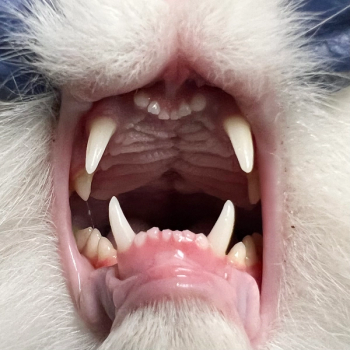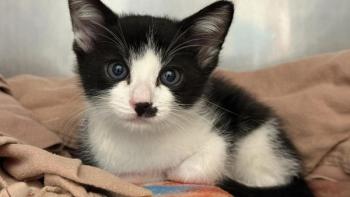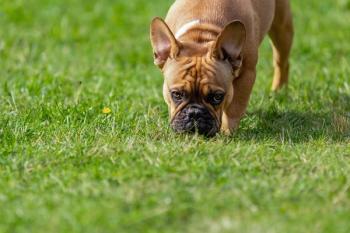
Essential reptile surgeries (Proceedings)
Reptile surgery is performed under general anesthesia, observing sterile technique, with appropriate monitoring and supportive care. The true strength layer for reptiles is the skin. To prevent dysecdysis after a skin incision heals, an everting suture pattern is used.
Reptile surgery is performed under general anesthesia, observing sterile technique, with appropriate monitoring and supportive care. The true strength layer for reptiles is the skin. To prevent dysecdysis after a skin incision heals, an everting suture pattern is used. Suture removal for reptiles is generally performed 6 weeks postoperatively, after shedding has occurred.
Follicular stasis/egg retention/dystocia
Gravid reptiles are commonly presented for failure to produce eggs or young. The causes may include inappropriate nesting sites, stress, dehydration, malnutrition, obesity, salpingitis, malformed eggs, or abnormal reproductive anatomy.
• Snakes: Surgery is indicated if medical therapy, egg manipulation, and/or ovocentesis have failed. An incision is made between the first and second row of lateral scales over the retained egg or fetus. The oviduct is isolated and a salpingotomy is performed. The egg/fetus is removed through the incision, and adjacent eggs are gently massaged toward the incision for removal. If adhered to the oviduct, these may need to be removed by multiple oviductal incisions. With absorbable monofilament (i.e. 4-0 to 5-0 PDS), close the oviduct and the coelom, each in simple continuous pattern. Close the skin with 4-0 to 2-0 monofilament nylon in an everting horizontal mattress pattern.
• Lizards: The clinician must differentiate between follicular stasis (pre-ovulatory stasis) and egg retention (post-ovulatory stasis). Cases of follicular stasis can be offered ovariectomy as an "elective" procedure, or given the option to monitor and see if yolks are reabsorbed later. Cases of egg retention may respond to medical therapy (oxytocin and calcium injections). If eggs are not laid within 48 hours, then surgery is recommended. In order to avoid the ventral abdominal vein a paramedian abdominal incision is often advised. A long incision provides the best access to the ovaries and reproductive tract. Use care to avoid damaging the bladder, which can be very large. The ovaries are located dorsally in the mid-coelomic cavity.
In preovulatory stasis, ovaries resemble a large cluster of egg yolks. Each ovary is carefully elevated out of the abdomen to expose its vascular supply. The left ovary is attached to a branch of the renal vein. The left adrenal gland (light pink in color) is located between the ovary and the renal vain, and care must be taken not to damage or accidentally remove it while ligating the vessels to the ovary. Hemostatic clips make this process simple. The right ovary is attached directly to the vena cava. Removal is similar, but the right adrenal gland is located on the opposite side of the vena cava, away from the ovary, where damage is unlikely. The oviducts should be examined, but with follicular stasis removal is not necessary as long as both ovaries are removed.
With egg retention, the oviducts are filled with shelled eggs and are easily identified. One oviduct at a time is gently exteriorized. If the patient is to be used for future breeding, perform a salpingotomy is performed, as described for snakes above. In order to make manipulation of the eggs easier, warm sterile saline may be infused into the oviduct. Several incisions may be necessary. For non-breeding pets, ovariosalpingectomy is recommended. The vessels of the oviduct are segmentally ligated, freeing the oviduct from cranial to caudal. The caudal end of the oviduct is ligated as close as possible to the junction with the urodeum. Repeat the procedure on the opposite side. With the oviducts/eggs removed, the ovaries can be identified and removed, as above. This procedure is more difficult when the ovaries are small and inactive. Again, vascular clips make the procedure easier to perform. Care must be taken not to leave any ovarian tissue behind, or ectopic ovulation may result in the future. Closure is routine. The abdominal musculature is gently pulled together with continuous monofilament absorbable suture. The skin is closed with an everting horizontal mattress suture pattern.
• Chelonians: Turtles with dystocia may present for digging, restlessness, producing a small clutch, being past the due date, anorexia, depression, or straining. Eggs may be palpable through the inguinal fossae, but radiology is the most useful tool to confirm the presence and numbers of eggs. If the retained eggs are normal, then medical therapy should be attempted for several days until all eggs are laid. If medical therapy for dystocia is ineffective, or the eggs are malformed or too large to pass, then surgery is indicated.
The pre-femoral coeliotomy is less invasive than the plastronotomy approach. The patient is placed in dorsal recumbency, and the rear limb is pulled caudally and secured. A retractor may be used to widen the shell opening. A linear skin incision is made in a craniocaudal direction within the fossa, midway between the carapace and plastron. The thin musculature and coelomic membrane are carefully incised, and stay sutures are placed. The oviduct is elevated into the pre-femoral incision. An incision is made over the egg, it is aspirated to collapse it, and it is removed. Remove all of the eggs in a likewise fashion. Take care not to allow leakage of egg contents into the coelomic cavity. The oviduct is then closed with monofilament absorbable suture in a continuous pattern. The coelom and muscle layers are closed with interrupted sutures, and the skin is closed in an everting pattern.
Castration
Aggression is common in mature male iguanas. This behavior can be cyclical, coinciding with the menstrual cycle of its female owner. In other cases, aggression persists beyond this cycle, and may be a learned behavior. Orchiectomy may reduce aggression in many cases, but is not 100% successful. Aggression may continue for almost a year, until hormonal and environmental cues are eliminated. The surgical approach is similar to ovariectomy. The testes are 1-1.5 cm cream colored organs. The right testicle is in close association with the vena cava, the left testicle is closely associated with the left adrenal gland. Care should be taken not to disturb either of these structures. Removal is easier if hemostatic clips are used. Closure is routine.
Note: The coeliotomy approaches described above may be modified as needed in order to perform other abdominal surgeries (e.g. exploratory, GI foreign body removal, cystotomy, biopsies, cloacopexy).
Cloacal prolapse
The cloaca (Latin for sewer) is the common opening for the urinary, reproductive, and gastrointestinal tract of reptiles. It is divided into three chambers: the coprodeum, urodeum, and proctodeum (from proximal to distal, the first letters spell "CUP"). The coprodeum is the chamber into which the rectum empties; the second chamber, the urodeum, receives urinary and reproductive products; the third and most caudal chamber, the proctodeum, is the chamber through which all matter passes in transit to the vent opening.
Prolapses from the cloaca can be a serious and often life-threatening condition in reptiles. These may originate from the cloacal wall, reproductive tract, or intestine. Cloacal prolapse may occur secondary to chronic straining from egg laying, space-occupying abdominal masses, and yolk coelomitis. Prolapsed tissues are at risk of trauma, desiccation, infection, and ischemia. Affected animals should receive immediate medical attention. Prognosis depends on properly identifying the prolapsed tissue and initiating appropriate therapy in a timely manner. The oviduct may prolapse secondary to straining from dystocia. If eggs are still present within the prolapsed tissue, it may be possible to remove the eggs, close the oviduct, and replace the tissue into normal anatomical position. However, damaged tissue must be surgically removed, and a coeliotomy may be necessary for complete reduction or removal of affected tissue. Administer appropriate antibiotic and analgesic medications, and initiate treatment of any underlying cause.
Hemipenis/phalus prolapse
The hemipenis (snakes/lizards) or phallus (chelonians) may prolapse as a result of infection, trauma, or excessive/aggressive breeding. Additionally, the chelonian phallus may prolapse secondary to general debilitation, neurologic dysfunction, metabolic bone disease, or any cause of straining (constipation, parasites, GI foreign body, etc.). It may be possible to clean and replace affected tissues, if viable. Cold compresses, hypertonic solutions, and sedation may permit replacement of the organ into the cloaca (phallus) or hemipenal canal. Trauma, infection, or dessicaton may necessitate amputation. The organ should be fully everted and clamped at its base. Horizontal mattress sutures of an absorbable monofilament material are placed at the base, and the hemipenis/phallus is transected and removed. Appropriate antibiotic and analgesic medications should be administered, and treatment of any underlying cause should be initiated.
Abscesses
Reptile abscesses are generally caseous in nature. They are usually secondary to improper husbandry (e.g. low temperature, humidity problems, and poor sanitation) and may originate from cage trauma, bite wounds, or scratches. In the case of jaw abscesses, infection usually originates from the oral cavity without any evidence of trauma however there may be concurrent stomatitis. Severe jaw abscesses may lead to osteomyelitis. Aural abscesses in chelonians may be related to immunosuppression, poor nutrition, or other factors.
Patients are usually presented because of a noticeable swelling or asymmetry. Lameness, anorexia, or depression may be present. Swelling or lumps may be present over the jaw, rostrum, tympanum, long bones, toes, joints, spine, or tail. Overlying skin can be normal to necrotic. Radiographs can help to determine if bone is involved. The abscess should be lanced using aseptic technique. The abscess capsule should be cultured, and cytology performed. Aggressive flushing and curettage are necessary in order to remove all caseated material. In turtles, aural abscesses are approached by surgical removal of the lower half of the tympanum, followed by the steps above. If infection in a limb is severe or involves the bone, amputation, aggressive bone curettage, or the application of antibiotic impregnated PMMA might be appropriate. In all cases, adequate anesthesia and analgesia should be provided. Lidocaine can be used locally.
Abscesses should not be sutured closed. Surgical sites should be flushed with chlorhexidine or povidone iodine, followed by topical application of 1% silver sulfadiazine, once or twice daily until fully healed. Systemic antibiotics are typically indicated. A follow-up examination is recommended 1-2 weeks following surgery, and treatment should be continued for at least 21 days.
Tail amputation
Trauma, vascular compromise, bacterial, and fungal infections may all lead to necrosis of a reptile's tail. This occurs most commonly in lizards. Amputation of a portion of the tail may be indicated. Iguanas, geckos, and some skinks are able to regenerate their tails. The tail stump for these species should not be sutured unless a very proximal amputation is needed or the patient is older. The amputation site should be proximal to the demarcation between healthy and normal tissue. Using aseptic technique, the skin and muscle are sharply dissected down to bone. Then, the distal (necrotic) portion of the tail is broken off through a natural fracture plane. Inspect the proximal tail stump: healthy tissue is pink to red and may exhibit capillary bleeding, unhealthy tissue is tan, pale, and does not bleed. Excise more tissue if necessary. If vertebral bone extends beyond the muscle tissue of the stump, a rongeur is used to whittle the bone back just proximal to soft tissues. If regeneration is expected to occur, the stump is washed with sterile saline and a pressure bandage is applied for 1-2 days. Topical medications may impede tail regeneration, so these are generally not applied. If regeneration is unlikely, then the stump can be closed using a side-to-side everting suture pattern.
Limb/digit amputation
Serious infections may necessitate removal of a limb or a portion thereof. Osteomyelitis is difficult to manage. Radiographs may aid in the diagnosis of osteomyelitis, which usually results in bony lysis. Amputation should occur proximal to the affected bone. Lizards and chelonians generally adapt well to such procedures. When removing a portion of the foot, the plantar flap should be longer than the dorsal flap in order to keep the incision off of the contact surface. Reptiles have such tough skin and close proximity to the ground that when a more proximal amputation is necessary, leaving a stump is acceptable. Muscle and soft tissue should be sutured over the end of the bone for padding, and the skin should be sutured as described for foot surgery above. Removal of an entire limb is performed as for other species at the scapulohumeral joint or coxofemoral joint accordingly.
Pharyngostomy tube
Indwelling feeding tubes make supportive feeding, hydration, and drug administration possible with a minimum of stress on the patient. This procedure is especially common in chelonians, but has applications in lizards and snakes, as well. The left side of the neck is prepped for surgery. A curved hemostat is passed into the pharyngeal cavity and pressed laterally, caudal to the mandible and hyoid apparatus, and a nick skin incision is made over the tip of the hemostat. For chelonians, the incision should be made caudally to minimize the movement of the tube as the head goes in and out of the shell. Avoid the jugular vein, which runs through this area. An appropriately sized red rubber urinary catheter should be pre measured and marked: from pharynx to mid-carapace in chelonians, to the last rib in lizards, and distal to the heart (where practical) in snakes. The tip of the catheter is grasped and pulled into the pharyngeal lumen and directed down the esophagus toward the stomach. A purse string suture is placed in the skin around the tube where it is marked. A Chinese finger trap or tape-butterfly is sutured in place for additional support. The tube is then bandaged to the neck, top of the head, or midline of the carapace in chelonians. Chelonians are prone to tube displacement because of the close proximity of their limbs. Using self-adhesive Velcro strips on the tube and carapace can prevent accidental removal by allowing a safe break-away to occur. The tube must be flushed before and after each use, and capped for protection. Antibiotics are recommended during the initial post-operative period. Feeding tubes can be maintained for weeks to months. After removal, the tube fistula generally closes without additional surgery.
Antibiotic impregnated PMMA beads
Antimicrobial-impregnated polymethylmethacrylate beads can be used to elute antibiotics for long-term treatment of infected lesions. Beads can be packed into tooth alveoli, abscesses, osteomyelitis lesions, joints, etc. after adequate surgical drainage and curettage has been performed. Beads may be left in and continue to elute antibiotics for weeks, months or years. Using sterile technique, 20 grams of bone cement (Howmedica, 877.946.9678) is mixed with either 1gm gentamicin or 1.25 gm amikacin. The mixture is quickly packed into sterile syringes and rapidly dispensed into long strings. These are, in turn, cut into small beads. Beads are packed into syringe cases in small quantities, then gas sterilized for later use.
Antibiotic selection
When possible, treat infections based upon culture and sensitivity. Ceftazidime 20 mg/kg SQ or IM q 72 h is the author's first choice for infections in snakes and chelonians, where injectable antibiotics are usually utilized. Enrofloxacin 10 mg/kg PO q 48 h works well for most lizards, where oral medication usually works. Enrofloxacin (Baytril 22.7 mg/ml injectable) can be administered IM or SQ, but there are anecdotal reports of necrosis and discoloration at injection site; therefore, the author recommends diluting the product 1:4 in saline prior to injection. Baytril 100 mg/ml (cattle formulation) is not recommended for injection in reptiles.
References and Further Reading
Mitchell MA, Tully TN, Eds. Manual of Exotic Pet Practice. St.Louis: Elsevier, 2009.
Sykes JM. Updates and practical approaches to reproductive disorders in reptiles. Vet Clin Exot Anim 2010;13(3):349-373.
Mader DR. Reptile Medicine and Surgery, Second Ed. St.Louis: Elsevier, 2006.
Meredeth A, Johnson-Delaney C. BSAVA Manual of Exotic Pets, Fifth Ed. BSAVA: Gloucester, England, 2010.
Mitchell MA, Medical and surgical considerations for green iguanas (Iguana iguana), Proceedings of the NAVC, 2001, 810-811.
Stahl SJ, Reptile obstetrics, Proceedings of the NAVC, 2000, 971-974.
Stahl SJ, Reptile surgeries you should know, Proceedings of the NAVC, 2000, 975-977.
Mader DR, Tail problems in the green iguana, Proceedings of the NAVC, 2002, 925-926.
Carpenter JW, Mashima TY, Rupiper DJ. Exotic Animal Formulary, 2nd edition. Philadelphia: W.B.Saunders Company, 2000.
Newsletter
From exam room tips to practice management insights, get trusted veterinary news delivered straight to your inbox—subscribe to dvm360.






